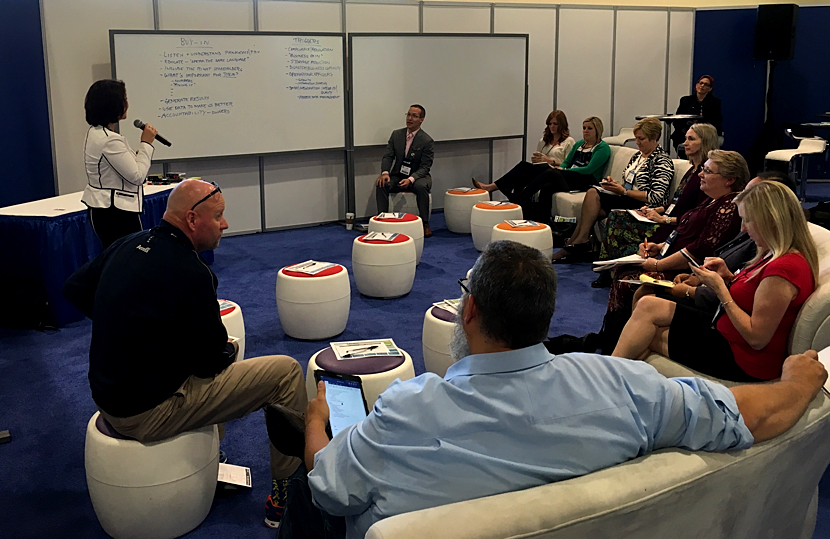
Image by: veger, ©2015 Getty Images
I had the opportunity to take part in an information governance (IG) roundtable at ARMA last week. The topic was getting buy-in for IG, and we had three presenters: Brian Starck from Alden Torch Financial, Courtney Stone from AMOCO Federal Credit Union and Jessica Harman from Phillips 66. They each shared where their IG programs are, which ranged from initial development to mature, as well as their thoughts on some of the critical success factors for getting buy-in. There was great conversation—three audience members actually volunteered during the Q&A to get up and share their IG stories as well—and I wanted to share some of the insights that came out of the session so folks who weren't there could benefit from the meeting of minds.

Jessica Harman and Joe Shepley lead discussion on IG buy-in.
1. Buy-in
The first topic we discussed was how to generate buy-in, both from the top-down and bottom-up, and although there were lots of good real-world examples, the group as a whole came up with some key guidance for individuals and teams looking to generate buy-in:
- Know your facts; get the data and numbers
- Include all the relevant stakeholders; don't leave anyone out
- Listen and understand their problems, issues, points of view
- What's important for them (e.g., hard numbers, being right, looking good, getting ahead, leaving it better than they found it, etc.)?
- Educate them so everyone is speaking the same language
- Establish accountability and ownership—both executives and leaders as well as "doers" (needs to be part of their performance metrics)
- Generate results—incremental, tangible
Find out what the "one big thing is" from the business! #ARMA15 @DOCUMENTmedia
— Jess Harman (@zz_jess) October 6, 20152. Business drivers
This was an interesting topic of conversation, because on the one hand, there are only three things that drive businesses: increase sales, decrease costs or increase margins. As one of our attendees put it, "Make more money" is a key driver, but the rubber hits the road when you drill down past this and get more specific, and our presenters and attendees did just that. Here's what we came up with for drivers for a successful IG program:
- Business pain
- Compliance/regulation
- Operational efficiency (e.g., growth, time and motion studies, information sharing)
- Disaster recovery and business continuity
- Data/information integrity and quality—master data management
- Storage reduction
- Information security and privacy risk mitigation and impact reduction
3. IG challenges
Honestly, I expected more to come out of the attendees and presenters on this topic—after all, the typical impression of IG is that it struggles at most organizations, but by the end of the workshop, we only had two items:
- IG focus too narrow (e.g., "just business records" or "only until the audit finding is closed")
- Strong personality/troublemaker with influence or power
- Organizational culture that resists change
- Federated business model (rather than centralized)
- Consensus-driven (rather than command-and-control)
- Long average employee tenure
- Low operational maturity but very profitable (especially if owned by larger organization or holding company)
Nice insight from Brian at #ARMA2015 from the @DOCUMENTmedia Roundtable with @joeshepley pic.twitter.com/cJ15W5kNb3
— Jess Harman (@zz_jess) October 6, 2015The final word
While we didn't solve the problem of IG buy-in, we did make good headway at the beginning to delineate some of the major themes for IG buy-in. Maybe more importantly, I think we saw first-hand how powerful it can be when you move the talking heads and so-called industry experts (I'm guilty as charged on both counts) out of the way and let real-world, end user practitioners take the stage and tell their stories. What comes out of it is usually less polished and can't be made into a slick four boxer, but inevitably, it reflects actual practice on the ground. Despite being a little rougher around the edges, it is usually more applicable to the day-to-day lives of folks out there trying to get IG right at their desks day-in and day-out, which is the goal—or, at least, it should be.
For more information on building information management strategies, don’t miss DSF ’17, May 1-3, 2017 in Downtown Chicago. Visit http://documentstrategyforum.com for details.
Joe Shepley brings more than 20 years of operational and technology experience to his consulting engagements at Doculabs, where he helps organizations get strategic around how they manage their information assets. To contact him, visit www.doculabs.com or follow him on Twitter @joeshepley.
Joe Shepley brings more than 20 years of operational and technology experience to his consulting engagements at Doculabs, where he helps organizations get strategic around how they manage their information assets. To contact him, visit www.doculabs.com or follow him on Twitter @joeshepley.
















